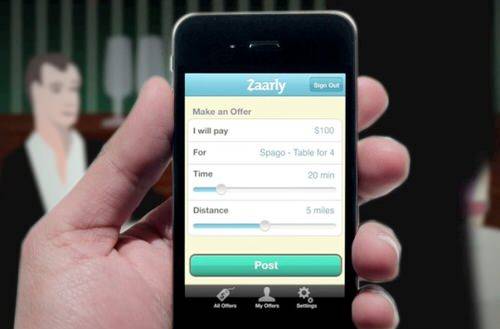As the president of Kauffman Labs, the Kauffman Foundation‘s program that supports entrepreneurship, Bo Fishback has seen a lot of startups. He’s heard a lot of pitches from companies who insist they’re “the next big thing.” So it would have to be a pretty “big thing” to make Fishback jump from what he admits has been “the greatest job in the world,” quit the Kauffman Foundation, and launch a startup of it’s own.

But that’s what he’s doing, effective immediately. And by many accounts, it appears that his new project Zaarly will be – something huge. Built a few weeks ago over the course of the LA Startup Weekend, Zaarly has been in a whirlwind since: winning first prize at the Startup Weekend, getting tweets from celebrities like Levar Burton and Demi Moore promoting his pitch, and now securing $1 million in funding from some big name investors, including Ashton Kutcher and Paul Buchheit.
So what is Zaarly? It’s a “proximity-based, real-time, buyer-powered market,” says Fishback. But a better explanation might invoke one of Demi Moore’s most famous movies, Indecent Proposal, and the notion that everything and everyone has a price. Zaarly’s job: facilitate that transaction.
A Market For Things That Have Never Had a Market
Zaarly aims to tap into the vast potential to buy and sell things that, until now, haven’t explicitly had a market. It’s a little bit eBay and a little bit Craigslist, but it’s mobile, real-time, and location-based. It’s also based on buying and selling experiences, in a way, more than simply goods and services – things we all value very differently.
Imagine, for example, that you’re at a basketball game, but you want to see if you can get better seats or you didn’t get reservations at some exclusive restaurant and you want to get in now. Zaarly lets you announce your willingness to shell out money – you name your price – for someone who can get the seats for you. Zaarly then facilitates the exchange.

How Zaarly Works
Using Zaarly, a buyer (that is, someone who’s looking for something, anything) enters their location, a description of what they want, the timeframe they need it in, and the price they’re willing to pay. Zaarly then broadcasts the message via Twitter (eventually, more options will be added here. This app was just built 2 weeks ago, remember?) Sellers (that is, those who are willing to agree to these terms and sell the good or service) can accept. Zaarly connects the buyer and seller on the phone, via an anonymous party-line, where the two can then rendezvous face-to-face to complete the transaction.
Will Zaarly Work?
Zaarly is set to launch during SXSW, which will be an excellent experiment for the startup as the event if full of early adopters who want to get into particular events and venues. Fishback says the app may require a “behavior change” as people move from buying and selling via eBay and Craigslist to the sort of more intimate transactions Zaarly will be able to foster.
Of course, those intimate transactions – as Craigslist has learned – may bring all sorts of legal questions for the startup, if the experiences folks look for – all those goods and services without an “official” market – are likely to include sex and drugs. Fishback says the company will scrutinize each offer that’s posted to Zaarly at first and will design a system to check for certain keywords and pull offending and illegal content.
Zaarly is currently free and Fishback says the company’s revenue model will probably involve taking a cut of credit-card and PayPal transactions. That’s the future that Fishback envisions for Zaarly, where with our mobile phones (and Square card readers) in hand, we can create a whole new buyer-controlled, geo-based market for everything.









